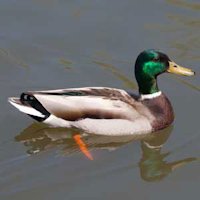
|
Some Common Myths Thought to be True - Myth 43
Myth 43: A Duck's Quack Does Not Echo
A duck's quack actually does echo, although the echo may be difficult to hear
for humans under some circumstances.
The cast of the television series MythBusters perform experiments to verify or
debunk urban legends, old wives' tales, and the like.
|
| A Duck | |
|
In audio signal processing and acoustics, an echo (plural echoes) is a
reflection of sound, arriving at the listener some time after the direct sound.
Typical examples are the echo produced by the bottom of a well, by a building,
or by the walls of an enclosed room and an empty room. A true echo is a single
reflection of the sound source. The time delay is the extra distance divided by
the speed of sound.
|
|
| ⇦ Back to Myth 42 Return to Myth Choices Page 3 On to Myth 44 ⇨ | |